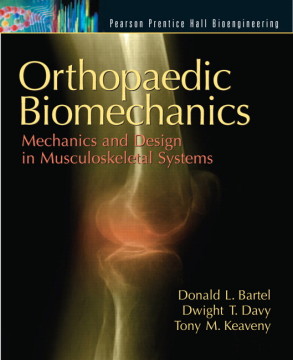Solution Manual for Orthopaedic Biomechanics: Mechanics and Design in Musculoskeletal Systems Donald L. Bartel, Dwight T. Davy, Tony M. Keaveny
$35.00 Original price was: $35.00.$26.50Current price is: $26.50.
Solution Manual for Orthopaedic Biomechanics: Mechanics and Design in Musculoskeletal Systems Donald L. Bartel, Dwight T. Davy, Tony M. Keaveny
This is completed downloadable of Orthopaedic Biomechanics: Mechanics and Design in Musculoskeletal Systems Donald L. Bartel, Dwight T. Davy, Tony M. Keaveny

Product Details:
ISBN 10: 0130089095
ISBN 13: 9780130089090
Author: Donald L. Bartel, Dwight T. Davy, Tony M. Keaveny
This book addresses the mechanical and structural aspects of the skeletal system – along with the analysis and design of orthopaedic implants that are used to repair the system when it is damaged. Focuses on applications of mechanical engineering in orthopaedic biomechanics, quantitatative modeling, and improving the reader’s understanding of mechanics. Introduces the musculoskeletal system, determining loads and motions, the structure and properties of bone and soft tissue, and stress analysis of biomechanical systems), as well as introducing applications of the material (including a basic introduction to bone-implant systems, fracture fixation devices, hip replacements, knee replacements, and articulating surfaces). For those interested in orthopaedic biomechanics, as well as orthopedic surgeons who wish to learn more about mechanics and design in the musculoskeletal system.
Table of Content:
1. The Musculoskeletal System
1.1. Anatomical Overview
1.2. The Functions of the Musculoskeletal System
1.3. Bones
1.4. Joints of the Body
1.5. Soft Tissue Structures
1.6. The Hip, Knee, and Spine
1.7. Damage and Repair
1.8. Summary
1.9. Exercises
2. Loads and Motion in the Musculoskeletal System
2.1. Basic Concepts
2.2. Static Analysis of Skeletal System
2.3. The Musculoskeletal Dynamics Problem
2.4. Joint Stability
2.5. Summary
2.6. Exercises
3. Tissue Mechanics I: Bone
3.1. Introduction
3.2. Composition of Bone
3.3. Bone as a Hierarchical Composite Material
3.4. Elastic Anisotropy
3.5. Material Properties of Cortical Bone
3.6. Material Properties of Trabecular Bone
3.7. Hierarchical Analysis
3.8. Structural Anisotropy
3.9. Biomechanics of Bone Adaptation
3.10. Summary
3.11. Exercises
4. Tissue Mechanics II: Soft Tissue
4.1. Tendon and Ligament
4.2. Articular Cartilage
4.3. Intervertebral Disc
4.4. Muscle
4.5. Viscoelasticity
4.6. Summary
4.7. Exercises
5. Structural Analysis of Musculoskeltal Systems: Beam Theory
5.1. Basic Concepts
5.2. Symmetric Beams
5.3. Unsymmetrical Beams
5.4. Case Studies: Whole Bone Mechanics
5.5. Summary
5.6. Exercises
6. Structural Analysis of Musculoskeltal Systems: Advanced Topics
6.1. Beams on Elastic Foundation
6.2. Torsion of Noncircular Sections
6.3. Contact Stress Analysis
6.4. Summary
6.5. Exercises
7. Bone-Implant Systems
7.1. Implant Materials
7.2. Fracture Fixation Devices
7.3. Joint Replacements
7.4. Design of Bone-Implant Systems
7.5. Summary
7.6. Exercises
8. Fracture Fixation Devices
8.1. Fracture Repair
8.2. Mechanics of Intramedullary Rods
8.3. Combined Behavior of Bone and Rod
8.4. Mechanics of Bone Plates
8.5. Combined Behavior of Bone and Plate
8.6. Plate Fixation: Other Considerations
8.7. Irregular Bone Cross Section with a Plate
8.8. External Fixators
8.9. Controlling Callus Strains
8.10. Bone Screws and Effects of Holes
8.11. Other Issues and Complications
8.12. Summary
8.13. Exercises
9. Total Hip Replacements
9.1. Function: Kinematics and Loads
9.2. Fixation: Femoral Stems
9.3. Stresses in the Central Zone
9.4. BOEF and FEA Models for Bone-Stem Systems
9.5. Summary
9.6. Exercises
10. Total Knee Replacements
10.1. Knee Function
10.2. Knee Structure
10.3. Knee Replacements
10.4. Summary
10.5. Exercises
11. Articulating Surfaces
11.1. Damage Modes
11.2. Design: General Considerations
11.3. Summary
11.4. Exercises
Suggestions for Further Reading
Index
People Also Search:
orthopaedic biomechanics: mechanics and design in musculoskeletal systems
orthopaedic biomechanics: mechanics and design in musculoskeletal systems solution manual download pdf
orthopaedic biomechanics: mechanics and design in musculoskeletal systems download scribd
orthopaedic biomechanics: mechanics and design in musculoskeletal systems pdf
You may also like…
Solution Manual
Solution Manual for Engineering Mechanics, Statics, 7th Edition, J. L. Meriam, L. G. Kraige
Solution Manual
Systems Analysis and Design in a Changing World 7th Edition Satzinger Solutions Manual
Solution Manual
Solution Manual for Electronics Fundamentals: A Systems Approach Thomas L. Floyd, David M. Buchla
Test Bank
Instructor Manual For Cases and Exercises in Organization Development & Change by Donald L. Anderson












